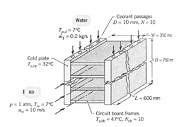Discuss teh below:
Q: One way to cool chips mounted on the circuit boards of a computer is to encapsulate the boards in metal frames that provide efficient pathways for conduction to supporting cold plates. Heat generated by the chips is then dissipated by transfer to water flowing through passages drilled in the plates cause the plates are made from a metal of large thermal conductivity (typically aluminum or copper), they may be assumed to be at a temperature, Ts.cp.
(a) Consider circuit boards attached to cold plates of height H = 750 mm and width L = 600 mm, each with N = 10 holes of diameter D = 10 mm. If operating conditions maintain plate temperatures of Ts,cp = 32°C with water flow at m1 = 0.2 kg/s per passage and Tm,i; = 7°C, how much heat may be dissipated by the circuit boards?
(b) To enhance cooling thereby allowing increased power generation without an attendant increase in system temperatures, a hybrid cooling scheme may be used. The scheme involves forced air flow over the encapsulated circuit boards, as well as water flow through the cold plates. Consider conditions for which N cb = 10 circuit boards of width W = 350 mm are attached to the cold plates and their average surface temperature is Ts.cb = 47°C when Ts,cp = 32°C. If air is in parallel flow over the plates with u8 = 10 m/s and T8 = 7°C, how much of the heat generated by the circuit boards is transferred to the air?
